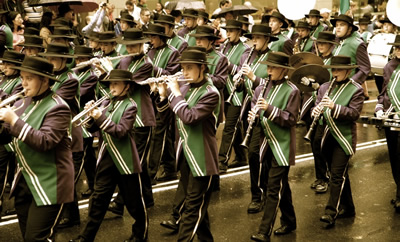
Hunter School of the Performing Arts Marching Band, Anzac Day Sydney, 2014
©Department of Education (HSPA)
This section provides syllabus related teaching and learning opportunities for students in the subjects of English, History, Geography, Science, Visual Arts and Languages.
The learning concepts of challenge, change, caring, community and commemoration form the focus of the teaching and learning. Questions for discussion and further investigation are listed for each concept.
For each subject area, teaching and learning activities are listed, the learning concepts are expanded and the syllabus outcomes and content are provided.
Through integrated learning, students can be engaged in inquiry that is relevant and that develops deep understanding of big ideas. Integrated learning provides opportunities to engage all students.
What is integrated learning?
Deep learning that draws on more than one discipline, and that is situated in authentic and engaging contexts for students.
Integrated learning is when a teacher or teachers draw on two or more learning areas to construct teaching and learning sequences to create deep learning in authentic contexts. Integrated learning explores key concepts, skills and processes from the syllabuses and their relationships to the real world. Students are engaged in inquiry that is relevant and that develops deep understanding of these big ideas.
'Research has consistently shown that students in integrated programs demonstrate academic performance equal to, or better than, students in discipline-based programs.' Drake & Reid (2010) page 1
‘Recent research on the brain affirms what many teachers know experientially. Students learn by making connections; the more connections they can make, the more they can learn,’ Caine & Caine, as cited in Drake & Burns (2004) page 26
‘Integrated approaches to teaching and learning are not new. A century ago, John Dewey and his contemporaries suggested that by applying ideas from one discipline to another, students would come to appreciate the interconnection of ideas and the relevance of their schooling.’ John Wallace, G. V. (2005)
English
Stage 4

Students explore the First World War origins of words and phrases commonly used today. They use Google Ngram Viewer to plot the frequency of some of the ‘trench talk’ words. Students analyse the results and write a brief history of one word’s usage. View English Stage 4.
Stage 5

Using the documentary Archdukes, Cynicism and World War I: Crash Course World History #36, students analyse the techniques documentary makers use to engage their audience. Students write an analysis of two moments in the documentary when Green uses humour as a way of engaging his audience.
Students use the texts Archdukes, Cynicism and World War I: Crash Course World History #36, The Soldier by Rupert Brooke and The Hero by Siegfried Sassoon to examine ways in which writers were influenced by the events of the First World War. Students write a response explaining influences on writers. View English Stage 5.
History
Stage 5

Using a variety of primary and secondary sources, students investigate how and why Australians commemorate wars and the ways in which specific wars and campaigns are recognised. Using a range of sources, students explore varying perspectives on the Anzac legend, including that of Aboriginal and Torres Strait Islanders. Students develop and communicate their own and other perspectives. View History Stage 5.
Geography
Stage 4

Students undertake a case study of the landscapes and landforms of five sites on the Gallipoli Peninsula. Drawing on their analysis of the aesthetic, cultural, spiritual and economic values of the Gallipoli landscape, they describe the value of Gallipoli for tourism. Students consider competing values and provide suggestions on how these can be managed. They create a detailed tourism blog post for potential visitors to the Gallipoli Peninsula. View Geography Stage 4.
Science
Stage 4

Students research an example of how changes in scientific knowledge have contributed to finding a solution to a human health issue in the context of the First World War. Students recount how evidence from a scientific discovery has changed understanding and contributed to solving a real world problem, for example, animal or plant disease, hygiene, food preservation, sewage treatment or biotechnology. View Science Stage 4.
Visual Arts
Stage 4

Students examine the works by Indigenous artist Tony Albert and consider the importance of the work in reclaiming a presence for Indigenous Australians in our national military history and collections. Students experiment with printmaking to create portraits of class members, layering text and stencilling to explore concepts related to ‘green skins’, inspired by Tony Albert’s work. View Visual arts Stage 4.
Stage 5

Students investigate the material practice of Ben Quilty, George Lambert and Napier Wallace. They use a range of materials and artmaking techniques to create works that explore the concept of emotional representation. Students create a large-scale portrait that uses expressive lines to capture emotion and is representative of an aspect of ‘the human condition’. They consider distortion of scale to amplify aspects of emotional paradox. View Visual arts Stage 5.
Languages
Stage 4

Students use primary sources to research examples of propaganda posters in the target language. They examine how language, symbols and images convey the message. Students design their own poster considering symbols, images, colours and the message to be conveyed. View Languages Stage 4.
Stage 5

Students read letters from home and the war front written in their target language during the First World War. They research everyday life during the period. Assuming the role of family member of a soldier on the front, students write a letter either about their daily life or the challenges the soldier faces. View Languages Stage 5.
